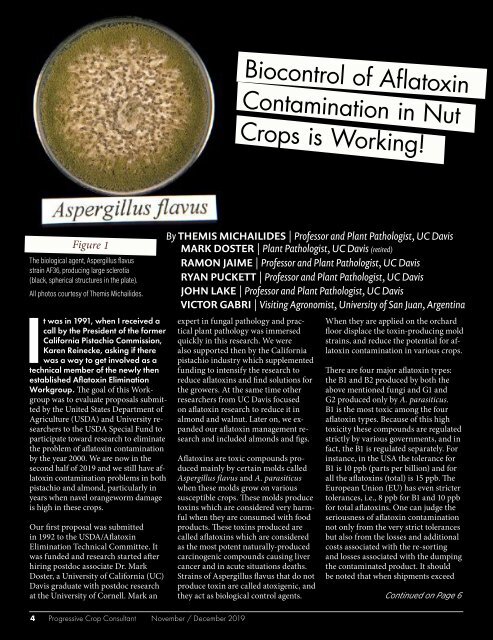You also want an ePaper? Increase the reach of your titles
YUMPU automatically turns print PDFs into web optimized ePapers that Google loves.
Biocontrol of Aflatoxin<br />
Contamination in Nut<br />
Crops is Working!<br />
Figure 1<br />
The biological agent, Aspergillus flavus<br />
strain AF36, producing large sclerotia<br />
(black, spherical structures in the plate).<br />
All photos courtesy of Themis Michailides.<br />
It was in 1991, when I received a<br />
call by the President of the former<br />
California Pistachio Commission,<br />
Karen Reinecke, asking if there<br />
was a way to get involved as a<br />
technical member of the newly then<br />
established Aflatoxin Elimination<br />
Workgroup. The goal of this Workgroup<br />
was to evaluate proposals submitted<br />
by the United States Department of<br />
Agriculture (USDA) and University researchers<br />
to the USDA Special Fund to<br />
participate toward research to eliminate<br />
the problem of aflatoxin contamination<br />
by the year 2000. We are now in the<br />
second half of <strong>2019</strong> and we still have aflatoxin<br />
contamination problems in both<br />
pistachio and almond, particularly in<br />
years when navel orangeworm damage<br />
is high in these crops.<br />
Our first proposal was submitted<br />
in 1992 to the USDA/Aflatoxin<br />
Elimination Technical Committee. It<br />
was funded and research started after<br />
hiring postdoc associate Dr. Mark<br />
Doster, a University of California (UC)<br />
Davis graduate with postdoc research<br />
at the University of Cornell. Mark an<br />
4 Progressive Crop Consultant <strong>Nov</strong>ember / <strong>Dec</strong>ember <strong>2019</strong><br />
By THEMIS MICHAILIDES | Professor and Plant Pathologist, UC Davis<br />
MARK DOSTER | Plant Pathologist, UC Davis (retired)<br />
RAMON JAIME | Professor and Plant Pathologist, UC Davis<br />
RYAN PUCKETT | Professor and Plant Pathologist, UC Davis<br />
JOHN LAKE | Professor and Plant Pathologist, UC Davis<br />
VICTOR GABRI | Visiting Agronomist, University of San Juan, Argentina<br />
expert in fungal pathology and practical<br />
plant pathology was immersed<br />
quickly in this research. We were<br />
also supported then by the California<br />
pistachio industry which supplemented<br />
funding to intensify the research to<br />
reduce aflatoxins and find solutions for<br />
the growers. At the same time other<br />
researchers from UC Davis focused<br />
on aflatoxin research to reduce it in<br />
almond and walnut. Later on, we expanded<br />
our aflatoxin management research<br />
and included almonds and figs.<br />
Aflatoxins are toxic compounds produced<br />
mainly by certain molds called<br />
Aspergillus flavus and A. parasiticus<br />
when these molds grow on various<br />
susceptible crops. These molds produce<br />
toxins which are considered very harmful<br />
when they are consumed with food<br />
products. These toxins produced are<br />
called aflatoxins which are considered<br />
as the most potent naturally-produced<br />
carcinogenic compounds causing liver<br />
cancer and in acute situations deaths.<br />
Strains of Aspergillus flavus that do not<br />
produce toxin are called atoxigenic, and<br />
they act as biological control agents.<br />
When they are applied on the orchard<br />
floor displace the toxin-producing mold<br />
strains, and reduce the potential for aflatoxin<br />
contamination in various crops.<br />
There are four major aflatoxin types:<br />
the B1 and B2 produced by both the<br />
above mentioned fungi and G1 and<br />
G2 produced only by A. parasiticus.<br />
B1 is the most toxic among the four<br />
aflatoxin types. Because of this high<br />
toxicity these compounds are regulated<br />
strictly by various governments, and in<br />
fact, the B1 is regulated separately. For<br />
instance, in the USA the tolerance for<br />
B1 is 10 ppb (parts per billion) and for<br />
all the aflatoxins (total) is 15 ppb. The<br />
European Union (EU) has even stricter<br />
tolerances, i.e., 8 ppb for B1 and 10 ppb<br />
for total aflatoxins. One can judge the<br />
seriousness of aflatoxin contamination<br />
not only from the very strict tolerances<br />
but also from the losses and additional<br />
costs associated with the re-sorting<br />
and losses associated with the dumping<br />
the contaminated product. It should<br />
be noted that when shipments exceed<br />
Continued on Page 6


















